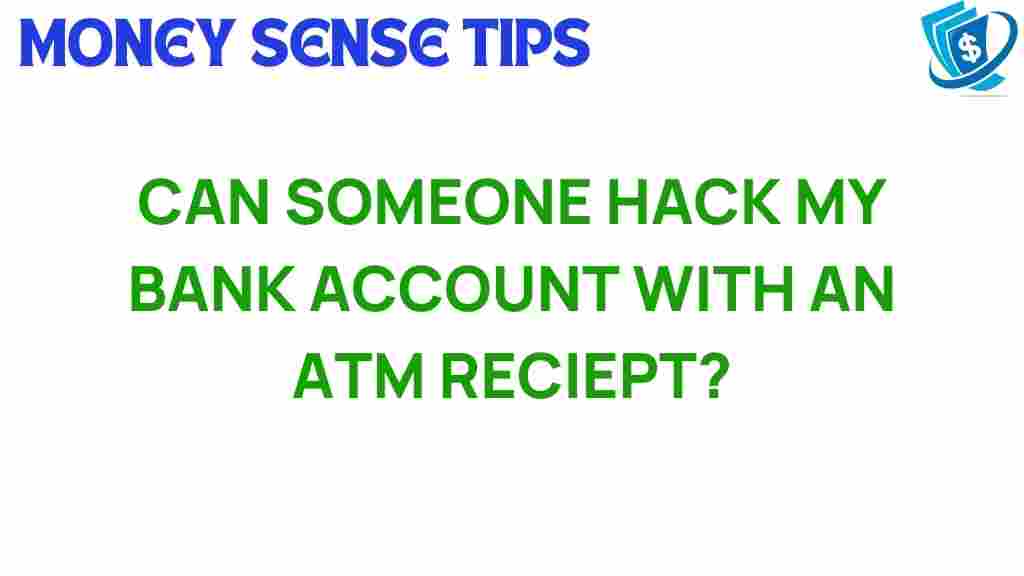Can Your ATM Receipt Expose You to Bank Account Hacking?
In today’s digital age, where cybercrime is rampant, maintaining bank security is more critical than ever. An often-overlooked aspect of bank security is the humble ATM receipt. Many people don’t realize that these small pieces of paper can expose personal information, making them vulnerable to identity theft and other types of fraud prevention issues. This article will explore how ATM receipts can be a potential gateway for cybercriminals, the associated banking risks, and the steps you can take to protect your financial safety.
Understanding ATM Receipts
ATM receipts are generated after you conduct a transaction at an Automated Teller Machine. These receipts typically contain important information, including:
- Your account number (partially masked)
- Transaction details (date, time, type of transaction)
- Balance information
- ATM location
While this information seems harmless, it can provide a treasure trove of data for a malicious actor. If you’re not careful, your ATM receipt could lead to significant banking risks.
The Risks Associated with ATM Receipts
ATM receipts can expose you to various forms of cybercrime. Here are some of the key risks:
- Identity Theft: If someone manages to obtain your ATM receipt, they may gather enough information to impersonate you.
- Account Hacking: Your partially masked account number could be used in conjunction with other stolen information to gain access to your bank account.
- Phishing Scams: Cybercriminals may use details from your receipt to create convincing phishing emails or messages aimed at tricking you into revealing more personal information.
The Step-by-Step Process of ATM Receipt Safety
To safeguard your personal information and enhance your financial safety, follow these steps:
1. Dispose of Receipts Properly
Do not simply throw your ATM receipts in the trash. Instead, shred them to ensure that no one can retrieve your information. This simple step can significantly reduce the risk of identity theft.
2. Review Your Receipts Regularly
Make it a habit to regularly review your ATM receipts against your bank statements. This practice can help you spot unauthorized transactions early, allowing you to take quick action.
3. Use Secure ATMs
Always use ATMs that are well-lit and located in secure areas, such as bank branches. Avoid using ATMs in secluded or unfamiliar locations, as these may be tampered with by criminals.
4. Monitor Your Bank Account
Keep an eye on your bank account activity through online banking. Set up alerts for any transactions, especially those that exceed a certain amount. This proactive approach can help you catch fraud before it escalates.
5. Protect Your Personal Information
Be cautious when sharing personal information. Only provide details when absolutely necessary, and be wary of unsolicited requests for information. Remember that legitimate financial institutions will never ask for sensitive information via email or text message.
6. Use Two-Factor Authentication
Enable two-factor authentication (2FA) on your online banking account. This adds an extra layer of security, making it more difficult for unauthorized users to access your account, even if they have your login credentials.
7. Be Wary of Public Wi-Fi
When accessing your bank account online, avoid using public Wi-Fi networks. These connections may not be secure, making it easier for cybercriminals to intercept your information. If you must use public Wi-Fi, consider using a Virtual Private Network (VPN) for added security.
8. Educate Yourself About Scams
Stay informed about the latest scams and fraudulent schemes. The more you know, the better you can protect yourself from becoming a victim of cybercrime.
9. Report Suspicious Activity
If you notice any suspicious activity on your account or receive phishing emails, report them to your bank immediately. Quick reporting can help prevent further damage and protect your finances.
Troubleshooting ATM Receipt Issues
Sometimes, you may encounter issues related to your ATM receipts or transactions. Here are some common problems and their solutions:
1. Missing ATM Receipt
If you don’t receive a receipt after a transaction, check your bank statement to confirm the transaction. If it appears, you can choose to print a duplicate receipt at the ATM or through your online banking portal. If it doesn’t appear, contact your bank for assistance.
2. Incorrect Information on Receipt
Should you find any discrepancies on your ATM receipt, such as incorrect amounts or transaction details, immediately report this to your bank. Keeping records of your transactions can help resolve these issues.
3. ATM Malfunction
If the ATM dispenses cash but does not provide a receipt, take note of the transaction details and report it to the bank. They can often review the transaction records to verify your claim.
4. Unfamiliar Transactions
If you see transactions on your receipt or bank statement that you do not recognize, do not hesitate to contact your bank. They can help you investigate these unfamiliar transactions and protect your account.
Conclusion
Your ATM receipt might seem trivial, but it holds critical information that, if misused, can lead to serious consequences such as identity theft and bank account hacking. By taking proactive steps to protect your personal information and following best practices for fraud prevention, you can significantly reduce the risks associated with your banking activities.
Remember: financial safety starts with you. Stay informed, stay vigilant, and ensure that your banking experience remains secure. For more information on enhancing your bank security, visit this helpful resource.
By understanding the risks and employing best practices for managing your ATM receipts and banking activities, you can better protect yourself from the growing threats of cybercrime. Your financial safety is worth the effort.
This article is in the category Security and created by MoneySenseTips Team
